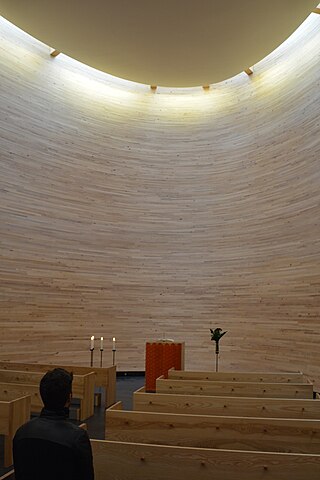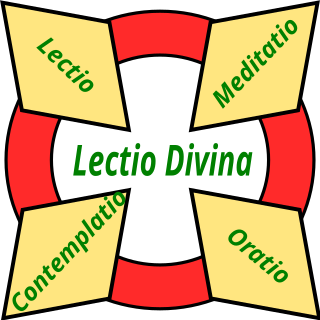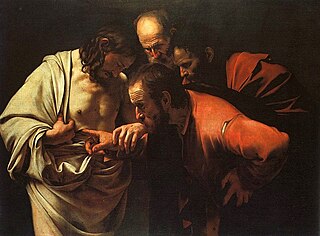
Teresa of Ávila, OCD, also called Saint Teresa of Jesus, was a Carmelite nun and prominent Spanish mystic and religious reformer.

John of the Cross, OCD was a Spanish Catholic priest, mystic, and a Carmelite friar of converso origin. He is a major figure of the Counter-Reformation in Spain, and he is one of the thirty-seven Doctors of the Church.

A vision is something seen in a dream, trance, or religious ecstasy, especially a supernatural appearance that usually conveys a revelation. Visions generally have more clarity than dreams, but traditionally fewer psychological connotations. Visions are known to emerge from spiritual traditions and could provide a lens into human nature and reality. Prophecy is often associated with visions.

Religious ecstasy is a type of altered state of consciousness characterized by greatly reduced external awareness and reportedly expanded interior mental and spiritual awareness, frequently accompanied by visions and emotional euphoria.

Christian mysticism is the tradition of mystical practices and mystical theology within Christianity which "concerns the preparation [of the person] for, the consciousness of, and the effect of [...] a direct and transformative presence of God" or Divine love. Until the sixth century the practice of what is now called mysticism was referred to by the term contemplatio, c.q. theoria, from contemplatio, "looking at", "gazing at", "being aware of" God or the Divine. Christianity took up the use of both the Greek (theoria) and Latin terminology to describe various forms of prayer and the process of coming to know God.

In a religious context, the practice of contemplation seeks a direct awareness of the divine which transcends the intellect, often in accordance with prayer or meditation.
The Dark Night of the Soul is a phase of passive purification of the spirit in the mystical development, as described by the 16th-century Spanish mystic and poet St. John of the Cross in his treatise Dark Night, a commentary on his poem with the same name. It follows after the second phase, the illumination in which God's presence is felt, but this presence is not yet stable. The author himself did not give any title to his poem, which together with this commentary and the Ascent of Mount Carmel forms a treatise on the active and passive purification of the senses and the spirit, leading to mystical union.

Christian meditation is a form of prayer in which a structured attempt is made to become aware of and reflect upon the revelations of God. The word meditation comes from the Latin word meditārī, which has a range of meanings including to reflect on, to study, and to practice. Christian meditation is the process of deliberately focusing on specific thoughts and reflecting on their meaning in the context of the love of God.

In Western Christianity, Lectio Divina is a traditional monastic practice of scriptural reading, meditation and prayer intended to promote communion with God and to increase the knowledge of God's word. In the view of one commentator, it does not treat Scripture as texts to be studied, but as the living word.
Spiritual direction is the practice of being with people as they attempt to deepen their relationship with the divine, or to learn and grow in their personal spirituality. The person seeking direction shares stories of their encounters of the divine, or how they are cultivating a life attuned to spiritual things. The director listens and asks questions to assist the directee in his or her process of reflection and spiritual growth. Spiritual direction advocates claim that it develops a deeper awareness with the spiritual aspect of being human, and that it is neither psychotherapy nor counseling nor financial planning.
The Spanish mystics are major figures in the Catholic Reformation of 16th and 17th century Spain. The goal of this movement was to reform the Church structurally and to renew it spiritually. The Spanish Mystics attempted to express in words their experience of a mystical communion with Christ.

In Christian theology, a private revelation is an instance of revelation, in a broader sense of the term, of divine reality to a person or persons. It contrasts with revelation intended for humanity at large, which is sometimes termed public revelation.

Interior life is a life which seeks God in everything, a life of prayer and the practice of living in the presence of God. It connotes intimate, friendly conversation with Him, and a determined focus on internal prayer versus external actions, while these latter are transformed into means of prayer.

Réginald Marie Garrigou-Lagrange was a French Dominican friar, philosopher and theologian. Garrigou-Lagrange was a neo-Thomist theologian, recognized along with Édouard Hugon and Martin Grabmann as distinguished theologians of the 20th century. As professor at the Pontifical University of Saint Thomas Aquinas, he taught dogmatic and spiritual theology in Rome from 1909 to 1959. There he wrote The Three Ages of the Interior Life in 1938.

A number of people have claimed to have had visions of Jesus Christ and personal conversations with him. Some people make similar claims regarding his mother, Mary. Discussions about the authenticity of these visions have often invited controversy. The Catholic Church endorses a fraction of these claims, and various visionaries it accepts have achieved beatification, or even sainthood.

Mental prayer is a form of meditational prayer, "performed without aid of any particular formula." It is distinguished from vocal prayers, "prayers performed by means of a given formula." The aim of mental prayer is 'to inflame souls with the love of God' and 'live without sin'. In mystical practice, it is to be followed-up by contemplative prayer.
The Three Ages of the Interior Life: Prelude of Eternal Life is the magnum opus of Fr. Réginald Garrigou-Lagrange, a French theologian of the Order of Preachers. The two volume publication represents both the summary of teaching ascetical and mystical theology for twenty years at the Angelicum and the synthesis of two other works: Christian Perfection and Contemplation and L’amour de Dieu et la croix de Jesus. The work is framed according to three stages that mark the common path of Christian perfection, which are described in conformity to the preexisting theology and wisdom of Catholic saints and Church Fathers. His synthesis has become one of the most the dominant present-day interpretations of this patrimony.
In Catholic spirituality, spiritual dryness or desolation is a lack of spiritual consolation in one's spiritual life. It is a form of spiritual crisis experienced subjectively as a sense of separation from God or lack of spiritual feeling, especially during contemplative prayer. It is thought that spiritual dryness can lead to greater love of God.
Instrumentality is a theological theory that falls under the broader category of the prophetic model of biblical inspiration. Those who espouse the prophetic model consider the authors of all the books of the bible to have been inspired in the same way prophets have been inspired by God to preach. Although, as Réginald Garrigou-Lagrange notes, a prophet can act based on direct revelation from God or from inspiration.













